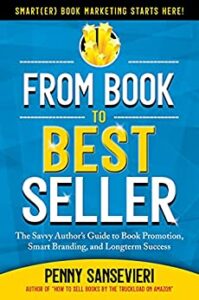 by Penny Sansevieri
by Penny Sansevieri
The book market is more competitive and more saturated than ever before. There is, quite literally, an endless funnel of fresh books hitting the shelves every day. While indie publishing might be easier than ever, that doesn’t mean book marketing is any less of a challenge.
Before you share your book with the masses, you need to consider all of the factors that go into attracting readers for your specific genre or topic. Whether this is the year you publish your debut novel or sell your fiftieth installment, these tips will help you impact the success of your book.
1. Have a Defined Readership and Genre
You might be thinking you can check this one off the to-do list. Before you do, take a moment to consider your reader market. You’d be surprised how many authors have tried publishing their book without defining their readership.
Write down what your genre is and who your reader market is. Now, take a minute to do some recon.
It’s important to know where you belong, and by “belong” I mean where your book will sit on the virtual shelf. One of the biggest mistakes authors make is what I call genre-straddling or not assuming they can just show up and create their own genre.
If you’re reading this thinking, “I have a unique book that’s never been done before,” you may want to ask yourself why.
There’s a reason publishers often say there are no new ideas. There just might not be a readership for this specific story. At least, not yet.
For example, twenty years ago you would have never found a book on social media, but now there are hundreds. So, there are new ideas as long as pop culture and society and specific industries continue to evolve.
Generally though, it’s good to make sure you have a readership ready and waiting for books like yours because publishing a book that has to push a new idea to an audience that isn’t ready for it, or hasn’t heard of it, is very difficult.
2. Model Traditional Publishing
You may never aspire to get a traditional publisher, but when it comes to publishing a book as an indie author, you should still let their retail examples become your guide.
Things to consider are color palettes that match your particular reader market, cover styles, book layouts and all-around book presentation. Following style guidelines is important, not just to your reader market because they expect to find books based on visual appeal, but to your brand’s longevity as well.
3. Think Long-Term
Speaking of your overall brand. Thinking about where you want to be long-term helps you create a book that will not only attract readers but will also lay the groundwork for your future books.
For example, let’s say you have a book series planned. You may want to consider creating mockups of covers for the entire series (even if you haven’t finalized future book titles). And while this may sound like a lot of extra work, for authors who know they have a series planned, it’s a really good way of visualizing what the entire series will look like, which can help with your website design, too.
If you aren’t sure what your publishing future looks like, it’s still good to consider some long-term goals or benefits that publishing a book offers you.
Maybe your nonfiction book will help you launch your future speaking career. Or maybe it can promote your future coaching services.
Why would knowing if you want to do speaking make a difference when publishing a book? Well, you can include that at the end of your last chapter. It’s easier to do that now rather than pulling the book and doing it post-publication day!
4. Be Aware of Formatting Standards
I’ve seen authors do really odd things with their book. They pick odd book sizes or do “unique” things with their interior formatting.
Oddly sized books make it difficult to get them stocked and shipped – they can also cost a lot more money to print and often can’t print through via traditional channels.
Book interiors are equally important.
Book formatting can be tricky to understand, but interiors matter, so self-designing these is always a mistake. This is a common place for authors to cut corners, but I wouldn’t recommend it. Some of the most common problems I see are too much white space on a page, or having pixelated images, which are bigger turn-offs to your readers than you might think.
5. Consider Brand Marketing and Start Early
Book marketing and brand marketing are different. Understanding how they differ and how they complement each other is important when preparing for publishing.
Brand marketing starts before you have a book and can help give you a head start on the book marketing process.
Think of brand marketing as networking, with a twist.
Before even mentioning your upcoming release, you should be on social media establishing a cohesive, credible brand that suits your target audience. You should connect with influencers, test promotion language, narrow down hashtags, build reach. Eventually, all this work will better serve your book marketing.
The best time to network is when you have nothing to sell. You’ll be more authentic and thoughtful and less stressed about defining what’s actually moving the needle. Just being “out there” early on is as important as the work you do once the book releases.
6. Don’t Rush the Process
 There is no perfect time to publish a book. You might want to rush a book to release on a certain holiday or to premiere around a certain event, but don’t do it. Rushing to publish a book always brings with it challenges, mistakes, and often, unrealistic expectations.
There is no perfect time to publish a book. You might want to rush a book to release on a certain holiday or to premiere around a certain event, but don’t do it. Rushing to publish a book always brings with it challenges, mistakes, and often, unrealistic expectations.
And those are the hardest hurdles to overcome!
The key to publishing a book the right way is a well-developed, and well-executed, plan that starts far in advance of your publication date. Publishing something that can stand on the shelf next to any well-known author’s title and perform well is possible – you just have to prepare, plan, and continue to educate yourself along the way.
Penny Sansevieri, CEO and founder of Author Marketing Experts, Inc. (AME) and an adjunct professor at NYU, is a best-selling author and internationally recognized book marketing and media relations expert. Her company is one of the leaders in the publishing industry and has developed some of the most cutting-edge book marketing campaigns.
